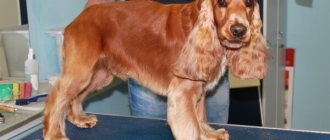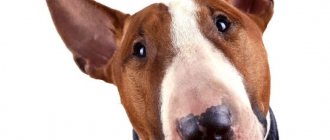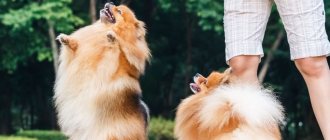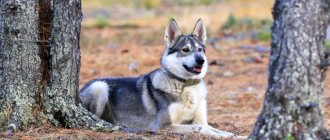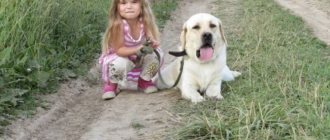- October 14, 2018
- Dogs and hunting with them
- Kira Ifeevskaya
When choosing a spaniel as a pet dog, you should understand that this is a very energetic and temperamental dog, and its direct purpose is to help the hunter. All his instincts and behavioral characteristics are aimed at this. Due to its small size, it can easily be kept in an apartment. But the owner must understand that there will be plenty of trouble with the spaniel. Given his hunting focus, he needs frequent and long walks, as well as physical exercise. In addition, you will either have to train them yourself, or take them to classes with a canine specialist. Of course, financially this can be quite expensive. Therefore, we will tell you how to train a spaniel at home.
Spaniels. History of the breed and its description
Spaniel dogs are beautiful and compact. They come from Spain, from where their ancestors were brought to England by the ancient Celts. From there they have already spread widely throughout the world. The Spaniel breed includes many varieties of dogs. The most popular and famous are English and American. The English version was developed artificially at the very beginning of the 19th century. When breeding this breed, the goal was to obtain an ideal hunting dog. And already in 1902 it was officially recognized. They even set strict standards for her that made it difficult to breed her. Today these requirements have changed, and the English spaniel has spread to different countries.
The American breed descended from the English cocker, brought to America in the 18th century. Their standards were based on American concepts of the beauty of a dog. Therefore, these two basic breeds differ from each other and from their predecessors. In the 40s of the last century, the English and American breeds were recognized as independent. Today, the American Cocker is the smallest of all hunting dog breeds. It plays more of a decorative function rather than being used for its intended purpose.
How and when to start training a spaniel?
The Cocker Spaniel is a small dog of decorative size. Its height does not exceed 35-38 cm. It is strong and muscular, fast and very hardy, has well-developed muscles and a tireless character. When purchasing a puppy of this breed, you should first ask what kind of care it needs and how to train a spaniel, because a real hunting dog must be well trained. Since the main function of such a dog is hunting, tracking down game, driving it, diverting attention from the hunter, a lot of attention will have to be paid to training. In order for a small, unintelligent puppy to grow into a true faithful friend and hunting assistant, some effort must be made. When asked about what age to train a spaniel, we can safely say that you need to start this painstaking process from the very first days of his stay in your home and after his adaptation. First, these will be the initial basics of education. Only after mastering these basics does real training begin.
How to raise a spaniel puppy? Now we'll tell you. A novice dog owner must learn that only one person will have to do the training. He should go hunting with the cocker. The period of adaptation of a dog to its owner sometimes lasts up to 7 months. A puppy adopted later will be slower to learn commands. Therefore, the optimal age when you should adopt a spaniel puppy is up to three months, you need to deal with it alone - raise it, walk it, train it. In the first months you need to devote a lot of time to the puppy, spend a lot of time together, and this is not easy.
Spaniel Club. All about spaniels.
A puppy is a big responsibility for its owners. The kind of dog that will grow up will depend on his upbringing and care. They begin to train the puppy from the moment he gets to his new home. There is no need to wait until he grows up and bad habits become difficult to correct. During the process of raising a young Cocker Spaniel, good habits are encouraged, bad habits are eradicated and taught to be groomed daily.
Dogs, like people, can have different personalities. Each puppy requires an individual approach when raising. Cockers can be:
- Cholerics. This is the majority of English Cocker Spaniels. They are active and unpredictable, and can be aggressive. When raising them, you should not shout or physically influence the puppy. They need to walk a lot and get used to new impressions and environments from childhood.
- Phlegmatic people are flexible. They are very friendly, but sedentary. Such a puppy needs to be forced to play, sometimes you need to shout at him so that he follows the command. Phlegmatic people are prone to obesity.
- Sanguine people are considered ideal cockers. A balanced dog will find a common language with any person, animal, and will play with children. They are the easiest to raise.
- Melancholic people are prone to cowardice. They require patience and affection when raising. The melancholic cocker is not suitable for hunting, but will become the best pet and companion for lonely people.
How to properly raise a Cocker Spaniel puppy?
While the puppy is small, its fur and claws do not require special care. However, from childhood it is necessary to accustom the spaniel to various procedures. A cocker puppy will not be able to sit in one place for a long time, so all procedures should last no more than 10 minutes. Grooming involves brushing. Choose a soft massage brush so that it does not scratch the skin. The matted fur is first sorted out with your hands and then with a metal comb. Don't pull the fur. Grooming begins with accustoming the puppy to scissors and their clicking sound. The hair in the ears and around the fingers is trimmed.
The puppy's nails are also not required to be trimmed. But he needs to be accustomed to the sight of a nail clipper. First, they simply take his paw in their hands, finger his fingers, constantly telling him how great he is, that he is sitting calmly. Teeth cleaning begins with an examination. You need to force the puppy to open its mouth, first run your hand over its teeth, and then use a brush and special toothpastes for dogs.
Also, the puppy must learn basic commands and obey the owners unquestioningly.
We invite you to watch a video about How to properly raise a Cocker Spaniel puppy..
Nickname
First of all, before raising a spaniel, you need to decide on his nickname. This combination of sounds should mean the command “come to me” for the dog, and the puppy should be taught this from the first days of acquaintance. The nickname should become a signal for him of attention and readiness to carry out subsequent commands of the owner. That is why, before giving any command, it is necessary to say the dog’s name. Adult, well-trained dogs no longer need this, but a baby simply needs it. The dog's name should be short and euphonious.
Getting used to shots
Another important factor is to accustom the puppy to the sound of gunfire. This is not done by choice, even weak shots have a negative effect on the young dog. She can get scared and always be scared from gunfire. Therefore, first it needs to be introduced to such sounds several hundred meters away. At the moment of the shot, the hunter must distract the dog from him. This is best done with affection and treats. The first time you need to shoot next to the dog in the direction of the game, which the dog itself will pick up. It is important to kill the bird and show it to the dog so that it can guess what the noise is for. In such cases, you need to shoot accurately during training. The dog will quickly and correctly understand bird hunting.
Then it is important to train your assistant to bring the killed game. We need to teach him to take game from the water, from the field. Spaniels love hunting on water. When a dog takes a bird from the lake, he will not leave it and will bring it to the shore. In this way, the behavior is reinforced that the game must be brought to the hunter. Dogs of this breed can disdain feathers. If you start training from the field, it takes more time, or the dog does not want to carry game at all.
A killed bird can be used for training several times. The dog will bring it, and the hunter will throw it back into the training area. This method is often used: the game that the dog brought is thrown back onto the field, and the assistant will gladly bring it. If this method does not work, and the assistant does not want to carry the bird into the field, use another method. To make training exciting, you need to agree with another hunter so that he approaches the killed bird with a trained, experienced dog. This usually works on other dogs, because when it sees an enemy taking its prey, the dog runs after the bird and carries it.
Team "place"
How to raise a spaniel puppy? Simultaneously with choosing a name and teaching the dog to it, it is necessary to determine a permanent place for it. The puppy, when given the “place” command, must clearly understand where it should go. After this command, the baby will first have to be carried to the corner allocated for him in his arms until he gets used to following this command. And here it is already important to apply some elements of training. After strictly following the command, treat the dog with something tasty, stroke it, saying his name. Praise should be pronounced softly and affectionately, and commands should be pronounced clearly and firmly, so that the puppy can distinguish one from the other. When teaching him to a place, it is very important to give the command “place”, and not its variations, incomprehensible to the dog, “to place” or “to place”. This will confuse the dog and delay the learning process.
How to raise an American Cocker Spaniel puppy
If you train your pet correctly, then over time you will get an obedient dog that will follow all commands and delight you every day. Experts believe that several factors may influence the American Cocker Spaniel's susceptibility to following various commands:
- pet's temperament - the speed of the pet's reaction to stimuli, both positive and negative;
- character - how exactly the dog resists various unpleasant influences;
- obedience - the dog’s ability to accept human leadership;
- vigilance - the speed with which the dog notices potential danger, both in relation to itself and in relation to the owner;
- aggressiveness - the pet’s ability to react hostilely to potential danger;
- curiosity - interest that is developed when a dog feels, hears and sees something;
- sociability - the ability to interact with people;
- possessiveness is the interest shown by animals in certain objects, for example toys.
How quickly your dog will learn commands depends on what specific traits predominate in the character of an American Cocker Spaniel puppy. By paying attention to the character traits of your animal, you can find an approach to it and adjust its behavior in certain situations.
- Eagerness will get you nowhere . You should not try to teach an American Cocker Spaniel puppy all the commands at the same time; you need to learn the commands one by one. You need to have patience and act methodically. You should not scold your pet at the moment when he makes mistakes, and when he succeeds in something, then the pet should be encouraged.
- Don't hit . It is prohibited to use physical punishment against a pet. You should limit yourself to variable intonation, but avoid shouting. After an American Cocker Spaniel puppy turns three months old, it is allowed to use a light spank as punishment while saying the phrase “Ew.” It is necessary to punish immediately when the animal commits an offense, and not after it, since the animal simply will not understand what exactly it was punished for.
- Subsequence . The main goal is to ensure that the pet follows the command the first time. Commands should be pronounced clearly and in an even voice so that the dog understands and obeys you. All family members should be involved in raising the dog, but they must act together. It is forbidden to allow situations in which you scold the puppy, and another family member praises him or simply does not pay attention.
- Pamper . Remember to reward your American Cocker Spaniel puppy with treats and praise when he has done what is asked of him.
Maintaining cleanliness, walking
Speaking about how to train spaniel puppies, it should be noted that from the age of two months the puppy must be taught to keep the apartment clean. If the possibility of taking him outside is not hampered by the number of floors, then after each feeding the puppy should be taken outside and walked with him in the same place until he fulfills the natural needs of the body. This way he will get used to doing these things while walking. When your pet starts asking to be walked after feeding, running up to the front door and whining, be sure to open the door and escort him to the walking area. By the age of four months, the puppy will have fully mastered this science and will keep the apartment clean.
Continuing to talk about how to train a spaniel, we need to talk about how to maintain cleanliness if the apartment is on a higher floor and he himself cannot be allowed out yet? In this case, not far from the baby’s rookery, you should install a box 60 x 60 x 5 cm with sand poured halfway, where the puppy should be taught to send natural needs between walks. To achieve this result, you need to carefully observe how your pet behaves. If he starts to rush around, looking for a place for himself, you should immediately take him to the box, keeping him there until he relieves his needs. When the baby reaches the age of four months, the box should be removed and the animal should begin to be walked outside.
Collar and leash training
How to train spaniel puppies? In this matter, it is necessary to pay attention to accustoming the dog to a collar and leash. Training should begin at the age of three months, at the time when he is taken out for a walk or for a walk. In order for the baby to get used to wearing a collar and free movement on a leash, you need to call him to attention by saying his name and putting on a collar with a leash. Afterwards, you should open the door and, holding the leash, let the puppy out of the apartment in front of you. If he resists walking on a leash, show him a treat while lightly tugging on the leash. When he understands what is required and goes for a walk with a leash, you should give him a treat and stroke him as you move on.
Those who are just learning how to train a cocker spaniel need to learn that after each successful execution of a command, the dog should be rewarded with stroking, treats and words of praise. And in this case, after a successful walk, the puppy needs to be pampered with something tasty. At the same time, unfastening the leash, but leaving the collar on. After a few walks with rewarding moments, the puppy will fully understand the science and will not resist walks with a leash. Moreover, buckling up will be a signal for him to start such a desired walk.
It should be noted that training a spaniel at home takes a lot of time and requires maximum concentration from the owner. It is especially difficult for those who have become the owner of a pet dog for the first time and still have little idea of what they will have to do. But everyone once had to do this for the first time. Therefore, do not despair and go through this school with your pet. Next, we will tell you how to train a Russian spaniel correctly. Let's look at those teams that we haven't considered yet.
Training and training of the English Cocker Spaniel.
If you are looking for a hunting companion, choose a Cocker Spaniel. This dog has outstanding hunting abilities. In addition, such traits of the breed as high intelligence, quick reaction, excellent sense of smell, memory concentration, and the dog’s desire to please the owner make the learning and training process easy and fun. Attention! Important note: European Convention for the Protection of Pet Animals, Article 7 “No domestic animal shall be trained in a manner harmful to its health or condition, especially if it is forced or by means which cause injury or cause unnecessary pain, suffering or stress.” .
Cocker spaniel training consists of 2 stages:
- general training course (OCD) and
- special training course or coaching.
OKD includes such commands as “Sit”, “Stand”, “Lie down”, “Near”, and others. OKD is mandatory for any hunting dog. The puppy must firmly grasp the obedience commands, because on the basis of these commands you will build the dog’s training for hunting. Once your puppy has mastered obedience commands, move on to training him to hunt. Before training begins, the dog must understand that they want it to do something. Training should be based on repetition and consistency. Immediately after the correct execution of the command, reward the puppy with his favorite treat and praise him. Commands should be simple and short. For example: “Sit”, “Come to me”. Say them clearly, clearly and slowly. If the dog does not comply with the command, repeat it calmly without raising your voice. Keep your workouts short. In this case, the puppy perceives them as a game. Carry them out systematically, without long breaks, because the dog may forget what it was taught. You should teach your puppy to walk on a leash as soon as possible. When feeding or playing, put the collar on your dog and do not remove it until he gets used to it. At first, the puppy will try to rip it off. After your dog gets used to the collar, put on the leash. Let the dog pull it. Keep the leash short and prevent your dog from chewing on it. Once your dog gets used to the leash, lengthen it. During a walk, the dog should always walk next to its owner. In addition to commands given by voice, the Cocker Spaniel must understand commands given by hand. After the cocker spaniel has firmly mastered the obedience course, you can move on to hunting training. The main task of the English Cocker Spaniel is to hunt birds. First of all, the dog must be taught:
- understand whistle signals,
- serve items
- don't be afraid of water.
To train a cocker spaniel, purchase a leash 15-20 m long, a hunting whistle and a leash. First of all, you should teach your cocker spaniel the “Stop” command. This command is very important, since during a hunt the dog is eager to chase the bird and can scare away the game before approaching it for a shot. Do not use the “down” command under any circumstances, because the cocker spaniel must see where the bird falls. How to teach a Cocker Spaniel the “Stop” command? At the moment when the dog runs at a distance of 3-5 m from you, whistle and voice the command “Stop” when the dog turns its head towards you. If the command is executed correctly, reward the dog with a treat, pet it, repeating “Okay, stop.” Repeat this procedure several times during each walk. Over time, complicate the task - increase the distance between you and the dog - the dog should be passionate about something. For example, by chasing a cat, ensure that the dog certainly obeys the “Stop” command. In this case, you will not have problems in the field. Next, teach your dog the correct and trouble-free delivery using the command “Give.” This is a very important command. The dog must be able to fetch poultry from both land and water. Take your dog's favorite toy and throw it a short distance. Give the command “Give.” If the dog brought a toy and gave it to you, reward it with a treat and the words “Give it well.” Gradually increase the distance. During one training session, practice the “Give” command 4-5 times. If you did something wrong and the dog refuses to give the toy, stop training on the “Give” command for a month and start again after a month, but carefully. At the beginning of teaching the “Give” command, tease the dog, provoke it so that it grabs the toy. If the dog refuses to run after the toy, push the toy with your foot. Gradually, when practicing the “Give” command, the game with the dog is reduced. When you throw the toy, hold the dog for 15 seconds and then release him after the toy. The next step is to use the “Stop” command. After you throw the toy, give the command “Stop” and then “Give.” Accustoming to water and swimming Accustoming to water should begin in warm weather from 6-7 months of age. First, throw a stick or ball at a distance of 1 m from the shore in a shallow place with the command “Give” so that the dog can come up and take the object. After the dog brings the object, give the command “Give”, take the object and reward the dog. You cannot force a dog to enter the water with threats and punishment or give commands in a threatening tone. Gradually increase the distance from the shore to the abandoned object. Repeat no more than 3 times. One of the most difficult skills to teach a cocker is how to shoot. Cocker spaniels are very excitable animals. Therefore, they must be taught to calmly deal with gunshots and other sharp sounds. When the first shot is fired, the dog must be no closer than 150 m from the shooters. After each shot, the dog must be petted and calmed down. After this, the dog and the dog begin to approach the shooters, gradually reducing the distance to 20-25 steps. It is especially difficult to develop in a dog the instinct to retrieve prey immediately after shooting. Train your spaniel daily. Take him out into the field more often so that he gets used to the sounds of nature and gunshots. It is equally important to teach the spaniel how to search for game. During the search, it should move in a shuttle or zigzag manner. Take the dog on a leash and lead it 10m to the right, then 10m to the left, then forward. At the same time, repeat the “Hunt” command so that the dog associates this command with its movements. Get your dog used to the smell of birds. Scatter feathers across the field and give the command “Hunt”. The dog, moving right, left and forward (as you taught it), should find feathers and bring them to you. After that, be sure to reward her. And one last thing. The dog must take the prey and bring it to the owner without damaging it. Having taught the cocker spaniel possible commands, the owner can safely take him hunting with him.
Commands “no”, “take” and “sit”
When training a spaniel for use in hunting, the “no” command is very important, when the dog needs to be calmed, called to order, and restrained from some actions that could interfere with the hunter and frighten off the game prematurely. This command is also very relevant in everyday life to teach your pet to behave correctly and not do prohibited things. Training should be carried out during feeding, placing the puppy in front of a bowl of food and keeping him from starting the meal, saying “no”. After a while, give the command “take” and open access to food. Spaniels learn these commands quickly.
Another simple but important command is “sit”, to which the puppy is taught by light pressure on his croup synchronously with the pronunciation of this word. Having completed it, the puppy receives a treat and praise.
General recommendations
Spaniel training at home is hard work that does not tolerate inattention and letting the situation take its course. During training, the dog must learn not only to carry out any commands spoken by the owner. She must also understand and stop certain actions on the owner's command.
The training can be based on the training of I.P. Pavlov , which allows you to develop reflexes taking into account conditioned and unconditioned stimuli. The trainer can influence the dog using different techniques, for example, encouragement or prohibition. To turn a reward into a conditioned stimulus, you need to connect it with some kind of treat. With frequent rewards, the dog will quickly understand what is required of it, and this technique will have a beneficial effect on its attachment to its owner.
It is useless to force a spaniel to train. Neither a tug on the leash, nor a blow with a rod, nor a threatening intonation will make the spaniel obedient and flexible. On the contrary, they will be the reasons for the dog’s insecurity and fear of the owner. To prohibit your pet from doing something, just say the command “no”. Of course, at first it will not be easy to get used to the same leash or collar.
However, rather than screaming and hitting the animal, it is more advisable to come up with a more positive way to train it.
You should not jerk the collar sharply, even if your pet really wants to run away and explore the world around him.
By doing this, the owner shows superiority, but this does not contribute to proper relationships. The teaching principle should be based on team unity, action and encouragement.
For example, the “sit” command is taught by light pressure on the puppy’s croup. As soon as the pet sits down, he is praised and encouraged. The “take” command is taught during one of the feedings. Food is given to him on the command “take”, thereby teaching him patience, because the dog must understand the order. Otherwise, for example, when hunting, she may rush after the game ahead of time.
The “no” command begins to be practiced from the “young claws”, at the bowl. In this case, food is given with the command “take” so that the puppy understands that he is allowed to eat. At the initial stages of teaching the “no” command, you can use a leash. In the future, it is removed, trying to avoid physical impact. The “come” command is considered one of those that puppies get used to faster than others.
You can accustom a puppy to it in literally a month using reward techniques. You can invite him to your place by treating him to some delicacy. However, when calling your pet, you must remember and follow the order of actions. First they give a command, then they show a treat and only after that comes reinforcement. When training, you can use a whistle: it will serve as a kind of signal to carry out the command.
For more information on training a spaniel, watch the video below.
Command "come to me"
How to raise a spaniel? When answering the question, it’s worth talking about practicing such important and useful commands for the spaniel as “come to me,” “give,” and “look.” For a hunting dog, these are the fundamental commands associated with hunting.
When practicing the “come to me” command, you should be patient. But, as a rule, by the age of two months, puppies are perfectly able to perform it. When it’s time to feed and the baby is playing, call him by name and immediately show him a tasty piece. The command must sound before he sees the tasty treat. After he approaches, give him a treat and encourage him morally. Just don’t practice this command when the baby is still full and isn’t very interested in food.
"Seek" command
Those who are interested in how to raise a spaniel need to talk separately about the “search” command. Because for a hunting dog this is a professional skill. The training is not easy, but it brings pleasure to both the puppy and the owner, as it is carried out in a playful way. Before training, the dog should already be quite hungry. This way it will be easier for him to find pieces of boiled meat, with the help of which the command will be practiced. While someone distracts the puppy from your actions, hide one of the pieces of meat, cheese or crackers in the room and immediately give the command “search” until the dog discovers the tasty food himself.
Teaching the “give” command
When the puppy becomes adept at finding pieces of food in open spaces, start hiding them in secluded places. Then you can hide them on heights - boxes, bedside tables, chairs. After successfully mastering science, move on to a more difficult stage - searching for inedible objects. Here it would be best to use bird carcasses or dried bird fragments with feathers so that the dog can feel the taste. As soon as the baby discovers a hidden object, the command “give” must immediately follow, which he already knows, so the dog will bring the find directly into the hands of the owner.
Having thoroughly studied the issue of training, remember a simple rule: do not skimp on praise, emphasize with your voice that this is encouragement, while stroking your pet and showing your affection and satisfaction with his actions. But in order to finally clarify the topic, we should give some more advice from professional dog handlers that will help you in raising your pet.
How to train a spaniel? Tips from dog handlers
Raising and training a spaniel should begin as early as possible - from 2-3 months. A hunting dog must know only its owner, distinguish his voice and carry out only his commands.
Try to do without outside services to train the dog, otherwise he may get used to the instructor’s voice and not respond to your commands. During the period of memorizing the nickname, the puppy should be in pleasant, comfortable conditions - during play, stroking, walking, so that it is associated with pleasant events.
The place that will be allocated for the puppy’s permanent residence must be permanent, located away from the passage and closed from sunlight. It is best to make some kind of house from a cardboard, plywood or wooden box measuring approximately 50 x 60 x 50 cm with a small hole and a removable lid.
In the habitat of a two-month-old puppy, if this age occurred during the cold season, a warm rubber heating pad should be placed under the bedding while sleeping. If the baby wakes up and is playing, take it away so that he doesn’t chew it. The “sit” command should be accompanied by a raised hand; over time, the dog will respond to this gesture in the same way as to a voice command.
When training your dog, do not overdo it with commands. Because he may get tired of it, and he will stop perceiving science. When practicing the “come to me” command, you should simultaneously use a whistle, because at long distances a whistle is much more convenient.
Learning to “Sit”
For the Russian spaniel, as well as the English one, this order is the most used in frequency. It's quite easy to learn. Holding a treat in one hand and lightly pressing on the croup with the other, forcing you to sit down, you must order “Sit!”
When the four-legged dog follows the command, you need to reward it with a piece of tasty food and a soft word. To achieve this, you can use a leash to hold and lightly pull back.
You can move your hand with the treat over your head a little back, tracking the object of interest to him, he will definitely sit down. Over time, they practice the command, gradually increasing the distance from the owner.
On a hunt, such a command is used if it is necessary to calm down a heated spaniel so that he does not react to the shots of other hunters and remains in place if this is not necessary.
As a rule, after completing a command, the owner gives a piece of treat as a reward, so the dog will sit, turning to him in anticipation of a reward.
At home, such a reaction is quite acceptable, but when hunting it is not advisable, since, most likely, at this time the spaniel should follow the game with its eyes, so it is better to reward it with affection and a kind word.
